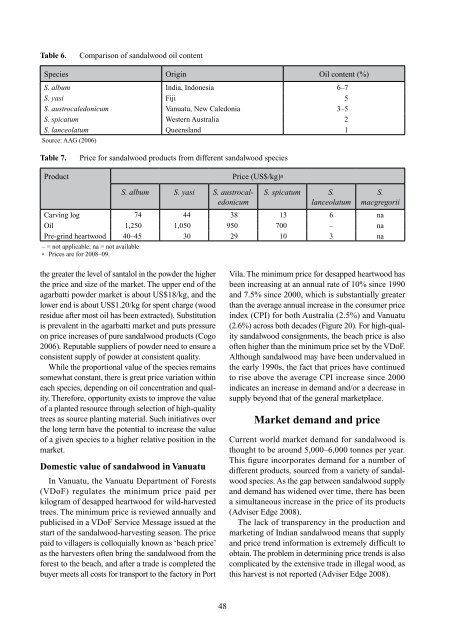Opportunities for the smallholder sandalwood industry in ... - ACIAR
Opportunities for the smallholder sandalwood industry in ... - ACIAR
Opportunities for the smallholder sandalwood industry in ... - ACIAR
You also want an ePaper? Increase the reach of your titles
YUMPU automatically turns print PDFs into web optimized ePapers that Google loves.
Table 6.<br />
Comparison of <strong>sandalwood</strong> oil content<br />
Species Orig<strong>in</strong> Oil content (%)<br />
S. album India, Indonesia 6–7<br />
S. yasi Fiji 5<br />
S. austrocaledonicum Vanuatu, New Caledonia 3–5<br />
S. spicatum Western Australia 2<br />
S. lanceolatum Queensland 1<br />
Source: AAG (2006)<br />
Table 7.<br />
Product<br />
Price <strong>for</strong> <strong>sandalwood</strong> products from different <strong>sandalwood</strong> species<br />
Price (US$/kg) a<br />
S. album S. yasi S. austrocaledonicum<br />
S. spicatum S.<br />
lanceolatum<br />
S.<br />
macgregorii<br />
Carv<strong>in</strong>g log 74 44 38 13 6 na<br />
Oil 1,250 1,050 950 700 – na<br />
Pre-gr<strong>in</strong>d heartwood 40–45 30 29 10 3 na<br />
– = not applicable; na = not available<br />
a Prices are <strong>for</strong> 2008–09.<br />
<strong>the</strong> greater <strong>the</strong> level of santalol <strong>in</strong> <strong>the</strong> powder <strong>the</strong> higher<br />
<strong>the</strong> price and size of <strong>the</strong> market. The upper end of <strong>the</strong><br />
agarbatti powder market is about US$18/kg, and <strong>the</strong><br />
lower end is about US$1.20/kg <strong>for</strong> spent charge (wood<br />
residue after most oil has been extracted). Substitution<br />
is prevalent <strong>in</strong> <strong>the</strong> agarbatti market and puts pressure<br />
on price <strong>in</strong>creases of pure <strong>sandalwood</strong> products (Cogo<br />
2006). Reputable suppliers of powder need to ensure a<br />
consistent supply of powder at consistent quality.<br />
While <strong>the</strong> proportional value of <strong>the</strong> species rema<strong>in</strong>s<br />
somewhat constant, <strong>the</strong>re is great price variation with<strong>in</strong><br />
each species, depend<strong>in</strong>g on oil concentration and quality.<br />
There<strong>for</strong>e, opportunity exists to improve <strong>the</strong> value<br />
of a planted resource through selection of high-quality<br />
trees as source plant<strong>in</strong>g material. Such <strong>in</strong>itiatives over<br />
<strong>the</strong> long term have <strong>the</strong> potential to <strong>in</strong>crease <strong>the</strong> value<br />
of a given species to a higher relative position <strong>in</strong> <strong>the</strong><br />
market.<br />
Domestic value of <strong>sandalwood</strong> <strong>in</strong> Vanuatu<br />
In Vanuatu, <strong>the</strong> Vanuatu Department of Forests<br />
(VDoF) regulates <strong>the</strong> m<strong>in</strong>imum price paid per<br />
kilogram of desapped heartwood <strong>for</strong> wild-harvested<br />
trees. The m<strong>in</strong>imum price is reviewed annually and<br />
publicised <strong>in</strong> a VDoF Service Message issued at <strong>the</strong><br />
start of <strong>the</strong> <strong>sandalwood</strong>-harvest<strong>in</strong>g season. The price<br />
paid to villagers is colloquially known as ‘beach price’<br />
as <strong>the</strong> harvesters often br<strong>in</strong>g <strong>the</strong> <strong>sandalwood</strong> from <strong>the</strong><br />
<strong>for</strong>est to <strong>the</strong> beach, and after a trade is completed <strong>the</strong><br />
buyer meets all costs <strong>for</strong> transport to <strong>the</strong> factory <strong>in</strong> Port<br />
Vila. The m<strong>in</strong>imum price <strong>for</strong> desapped heartwood has<br />
been <strong>in</strong>creas<strong>in</strong>g at an annual rate of 10% s<strong>in</strong>ce 1990<br />
and 7.5% s<strong>in</strong>ce 2000, which is substantially greater<br />
than <strong>the</strong> average annual <strong>in</strong>crease <strong>in</strong> <strong>the</strong> consumer price<br />
<strong>in</strong>dex (CPI) <strong>for</strong> both Australia (2.5%) and Vanuatu<br />
(2.6%) across both decades (Figure 20). For high-quality<br />
<strong>sandalwood</strong> consignments, <strong>the</strong> beach price is also<br />
often higher than <strong>the</strong> m<strong>in</strong>imum price set by <strong>the</strong> VDoF.<br />
Although <strong>sandalwood</strong> may have been undervalued <strong>in</strong><br />
<strong>the</strong> early 1990s, <strong>the</strong> fact that prices have cont<strong>in</strong>ued<br />
to rise above <strong>the</strong> average CPI <strong>in</strong>crease s<strong>in</strong>ce 2000<br />
<strong>in</strong>dicates an <strong>in</strong>crease <strong>in</strong> demand and/or a decrease <strong>in</strong><br />
supply beyond that of <strong>the</strong> general marketplace.<br />
Market demand and price<br />
Current world market demand <strong>for</strong> <strong>sandalwood</strong> is<br />
thought to be around 5,000–6,000 tonnes per year.<br />
This figure <strong>in</strong>corporates demand <strong>for</strong> a number of<br />
different products, sourced from a variety of <strong>sandalwood</strong><br />
species. As <strong>the</strong> gap between <strong>sandalwood</strong> supply<br />
and demand has widened over time, <strong>the</strong>re has been<br />
a simultaneous <strong>in</strong>crease <strong>in</strong> <strong>the</strong> price of its products<br />
(Adviser Edge 2008).<br />
The lack of transparency <strong>in</strong> <strong>the</strong> production and<br />
market<strong>in</strong>g of Indian <strong>sandalwood</strong> means that supply<br />
and price trend <strong>in</strong><strong>for</strong>mation is extremely difficult to<br />
obta<strong>in</strong>. The problem <strong>in</strong> determ<strong>in</strong><strong>in</strong>g price trends is also<br />
complicated by <strong>the</strong> extensive trade <strong>in</strong> illegal wood, as<br />
this harvest is not reported (Adviser Edge 2008).<br />
48
















